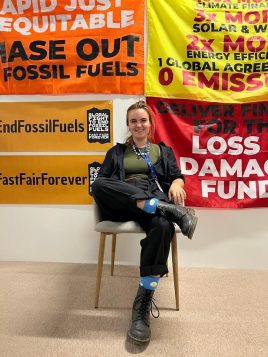Angelina Heil is currently an intern at the Arava Institute’s Center for Applied Environmental Diplomacy, researching the feasibility of a new approach to Israeli-Palestinian cooperation via the new mechanisms introduced in Article 6.2 and 6.4 of the Paris Climate Agreement. She shares below some of her reflections as one of the Institute’s delegates at the 28th United Nations Climate Change Conference in Dubai (COP28).
“Let’s foster inclusivity.
Let’s fast track the energy transition.
Let’s think without limits.
Let’s turn rhetoric into results.
Let’s act now.
Let’s turn agreements into action.
Let’s lead change.
Let’s focus on nature, lives and livelihoods.
Let’s be brave and bold together.
Let’s turn promises into progress.”

Interestingly, the president’s framing for achieving this followed the nature of the Paris Agreement, namely a bottom-up approach – however, in its own interpretation. Firstly, bottom-up was to be understood in a way in which the climate change agenda can only be achieved if we bring demand and use together, namely that it cannot just be about the supply side of energy but also our norms and values as consumers of energy, or buyers of food. Secondly, the president highlighted that we would achieve better conversations and implementation if we can keep in mind that we primarily have government-led discussions at COP, while in the end, it is companies that play the most important role in reducing emissions. Following this directive, COP28 included a lot of engagement with companies as to how to actually translate the intergovernmental transactions into more achievable and quantifiable targets.
In terms of numbers, COP gathered over 24000 lobbyists of the fossil fuel industry, presenting the second largest delegation at COP28 all together, only superseded by the delegation of Brazil. Similarly, the non-UN but presidency-managed Green Zone of COP28 incorporated the biggest scale in UNFCCC history.
While I think the concept of involving the main culprits of the climate crisis in its mitigation is inherently problematic discouraging, and even counterproductive, when I attended side events and met other civil society change makers, my discouragement was immediately replaced with increased motivation, drive, action and inspiration. As an observer, you are not only able to attend high-level events but also to engage in conversations, ask questions at roundtables, and connect. Similarly, us younger delegates quickly established a WhatsApp group, organized actions, and even demonstrations primarily featuring the voices of people from the Middle East, Africa, and Latin America. The table may not have been designed for us, but as delegates, we did have a seat and we did use our voice.
COP28 was not intended to host demonstrations, yet, every day we organized multiple actions, from public speeches, to interruptions, chants, and sit-ins. Every evening I would join the de-briefing in the youth pavilion, discuss the day, and plan new actions for the next day. We surely didn’t turn the world upside-down but we did achieve one thing: Pressure. Intensive pressure. That is, in the mornings at 8:30am as government negotiators started heading for the negotiation rooms, it was impossible for them to miss us, our chants, and our posters.
For many environmentalists, the outcomes of COP28 may not reach far enough, myself included. But I don’t want to dare imagining what the final texts would have looked like if younger activist delegates hadn’t been present and loudly shared stories of the urgency of the climate crisis. Leading up to COP28, COP28 President Dr. Sultan Al Jaber claimed that there is no scientific background to phase out fossil fuels. On December 3rd, at COP, he claimed to still be standing by that statement. Compared to these statements then, the final text on the Global Stocktake (GST) of COP28 stipulating “a transition away from fossil fuels” almost feels revolutionary, marking 2023 as the first time in history wherein “fossil fuels” were mentioned in a COP final text at all. Further, a Loss and Damage Fund was finally established after failed global attempts in the last 30 years.
This fund is not yet adequately filled, nor does the fossil fuel provision in the GST reflect the sense of urgency the world should be embracing. However, for the past decades, the world has never been able to do either, so at least some change has finally been achieved, though rather slower than some of us hoped for. I still left COP28 hopeful, having met so many change-makers from around the globe. The youth truly is becoming more present, taking up space, and is bringing about more and more of the change we want and need to see in the world.

